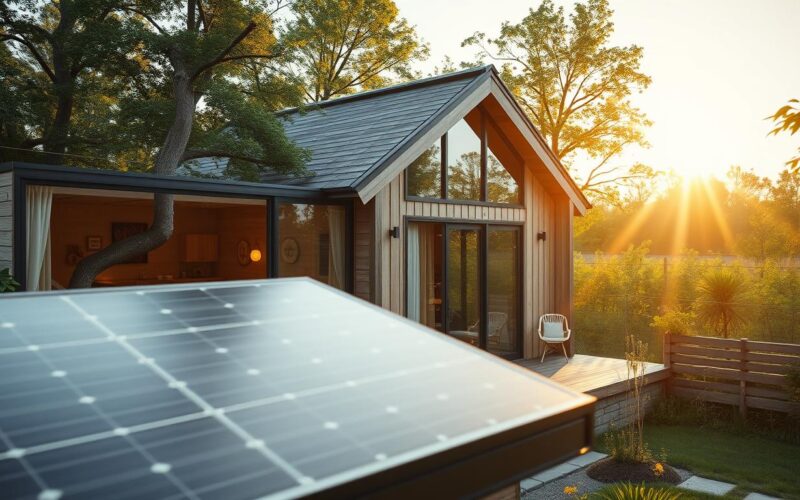Did you know that heating homes accounts for 13-14% of the UK’s total carbon emissions1? This startling fact highlights the significant impact our daily choices have on the environment. Adopting an eco-friendly lifestyle isn’t just a trend—it’s a necessity for preserving our planet for future generations.
Living sustainably means making thoughtful decisions that reduce your environmental impact. From energy-efficient appliances to eco-conscious shopping habits, every small change contributes to a healthier ecosystem. Companies like Soda Sense are leading the way with innovative solutions, such as their CO2 refill service, which minimizes waste and promotes sustainability.
This guide will explore practical steps to transform your home into an eco-friendly haven. You’ll discover how to balance modern conveniences with sustainable practices, ensuring a positive impact on the environment without compromising your lifestyle. Let’s embark on this journey together and make a difference—one choice at a time.
Key Takeaways
- Heating homes contributes significantly to carbon emissions1.
- Eco-friendly practices reduce environmental impact and promote sustainability.
- Innovative solutions like Soda Sense’s CO2 refill service minimize waste.
- Small changes in daily habits can make a big difference for the planet.
- Balancing modern conveniences with eco-conscious choices is key to sustainable living.
Introduction: Context and Purpose
Climate-related disasters are projected to rise to 560 per year by 2030, highlighting the urgency of sustainable living2. This guide aims to bridge the gap between modern conveniences and environmental responsibilities, offering practical solutions for a greener future.
Today, the world faces unprecedented challenges, from water scarcity affecting billions to the need for global greenhouse gas emissions to peak before 20252. These issues underscore the importance of adopting eco-friendly practices in our daily lives.

Small, informed changes can lead to significant environmental benefits. For instance, reducing waste and increasing water-use efficiency are key steps toward sustainability2. By making thoughtful choices, we can collectively reduce our environmental impact and preserve vital resources.
This guide explores essential concepts like renewable energy, waste reduction, and sustainable consumer behavior. It encourages readers to view eco-consciousness as a practical, accessible journey rather than a radical lifestyle change. Together, we can make a difference—one choice at a time.
Understanding Eco-Consciousness
The concept of eco-consciousness has evolved from grassroots movements to a global mindset. It’s about being aware of how our daily actions affect the environment and making choices that reduce our environmental impact. This awareness has grown significantly due to the increased visibility of climate issues3.
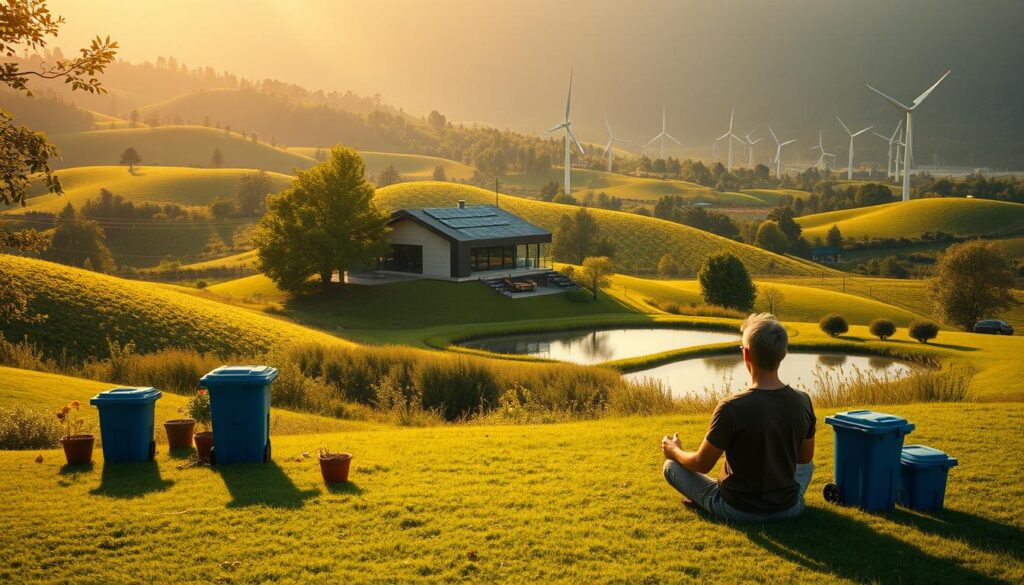
Definition and Origins
Eco-consciousness refers to the understanding that our choices—whether in shopping, energy use, or waste management—affect the ecosystem. Its roots trace back to grassroots movements in the 1960s and 1970s, when concerns about pollution and resource depletion first gained public attention. Over time, this awareness has expanded into a global movement focused on sustainability.
Historical milestones, such as the first Earth Day in 1970 and the rise of recycling programs, marked the shift toward sustainable living. Today, eco-consciousness is driven by a desire to protect the environment for future generations4.
Everyday Eco Practices
Adopting eco-conscious habits doesn’t require drastic changes. Simple actions like reducing waste, recycling, and choosing eco-friendly products can make a significant difference. For example, using post-consumer recycled materials in everyday items like dog poo bags helps reduce plastic waste5.
Mindful consumption is another key practice. This means considering the environmental impact of what we buy and opting for sustainable alternatives. Companies that prioritize transparency and sustainability are increasingly favored by consumers4.
By making these small changes, individuals can contribute to a larger, collective effort to protect the environment. Together, we can create a more sustainable future.
The Importance of Sustainability in Home Life
Adopting eco-friendly practices at home can significantly reduce your carbon footprint while enhancing your quality of life. Sustainability in home life encompasses multiple dimensions, from energy efficiency to waste reduction, each contributing to a healthier environment and a brighter future6.
Sustainable practices not only benefit the planet but also improve your living space. For instance, using energy-efficient appliances can reduce electricity usage by up to 50%, lowering monthly bills and decreasing carbon emissions7. Similarly, proper insulation can cut heating and cooling costs by up to 20%, making your home more comfortable and cost-effective8.

Another key aspect is improving indoor air quality. Low-VOC or no-VOC paints can reduce harmful emissions, creating a safer environment for your family8. Additionally, incorporating natural light and ventilation can decrease the need for artificial lighting by up to 40%, further enhancing energy efficiency7.
Here’s a quick overview of how sustainable practices can transform your home:
| Practice | Benefit | Impact |
|---|---|---|
| Energy-efficient appliances | Reduced electricity usage | Lower bills, smaller carbon footprint7 |
| Proper insulation | Decreased heating/cooling costs | Up to 20% savings8 |
| Low-VOC paints | Improved indoor air quality | Healthier living environment8 |
| Natural light and ventilation | Reduced artificial lighting needs | Up to 40% energy savings7 |
By making these changes, you’re not just protecting the environment—you’re also creating a more comfortable and cost-effective home. The long-term benefits of sustainable living extend beyond your household, contributing to a healthier ecosystem for everyone6.
As you explore these practices, you’ll find that small, thoughtful choices can make a big difference. In the next sections, we’ll dive deeper into advanced strategies for waste reduction, water conservation, and energy efficiency.
Embracing an Eco-Friendly Lifestyle in Today’s World
Living sustainably is no longer a niche choice but a global movement shaping our future. With 73% of consumers willing to change their habits to reduce their environmental impact, the shift toward eco-friendly living is undeniable9.
Modern solutions make sustainability accessible and practical. For example, switching to renewable energy can cut greenhouse gas emissions by up to 80% in residential settings9. Similarly, using LED bulbs saves 75% more energy than traditional bulbs, offering both efficiency and cost savings9.

Small daily changes can lead to significant outcomes. Plant-based diets, for instance, reduce an individual’s carbon footprint by up to 50% compared to meat-based diets9. These choices not only benefit the environment but also enhance personal health and well-being.
Technological advancements play a crucial role in this journey. Programmable thermostats can reduce heating and cooling costs by up to 20%, while solar panels save households thousands over time10. These innovations make sustainable living both affordable and effective.
Embracing an eco-friendly lifestyle is about enhancing quality of life while reducing harm to the ecosystem. By integrating small changes—like supporting sustainable brands or using public transportation—you can make a meaningful difference in the world9.
As the global market for eco-friendly products grows, consumers have more options than ever to align their purchases with their values9. This shift reflects a collective commitment to a healthier, more sustainable future.
Practical Waste Reduction Strategies for the Home
Reducing waste at home is one of the most impactful ways to protect the environment and conserve resources. With North Americans producing an average of 4.9 pounds of trash daily—three times the global average—adopting smarter waste management practices is essential11.
By focusing on the principles of Reduce, Reuse, Recycle, homeowners can significantly cut down on landfill waste. Small changes, like composting or switching to digital formats, can make a big difference in reducing your carbon footprint11.

Reduce, Reuse, Recycle
The foundation of waste reduction lies in the three Rs: Reduce, Reuse, Recycle. Start by minimizing waste at the source. For example, buying in bulk reduces packaging waste, while opting for reusable items like water bottles and shopping bags cuts down on single-use plastics12.
Reusing items is another effective strategy. Old jars can become storage containers, and worn-out clothes can be turned into cleaning rags. Recycling, when done correctly, ensures materials like paper, glass, and plastics are repurposed instead of ending up in landfills12.
Creative Repurposing Ideas
Repurposing everyday items is a fun and practical way to reduce waste. For instance, glass jars can be used as planters, and old furniture can be refurbished for a fresh look. Up to 25% of household trash could be composted, turning food scraps into nutrient-rich soil for gardens11.
Another creative idea is to turn old t-shirts into reusable shopping bags. This not only reduces textile waste but also provides a sustainable alternative to plastic bags. Textile production is projected to triple by 2050, making such practices even more crucial11.
Here’s a quick guide to effective waste reduction strategies:
| Strategy | Action | Impact |
|---|---|---|
| Reduce | Buy in bulk, avoid single-use items | Less packaging waste12 |
| Reuse | Repurpose jars, clothes, and furniture | Extends item lifespan12 |
| Recycle | Sort paper, glass, and plastics | Reduces landfill waste12 |
| Compost | Turn food scraps into soil | Nutrient-rich compost in 3-12 months11 |
Adopting these strategies not only benefits the environment but also fosters a sense of community by encouraging shared efforts toward sustainability. Small changes at home can lead to significant global impacts, making waste reduction a powerful practice for a healthier ecosystem.
Energy Efficiency and Renewable Home Solutions
Energy efficiency is a cornerstone of sustainable living, offering both environmental and financial benefits. Homes account for over 20% of carbon emissions nationwide, making energy-efficient upgrades a vital step toward reducing your environmental impact13.
Simple changes, like proper insulation and sealing ductwork, can prevent up to 30% of air loss, significantly improving energy efficiency13. These upgrades not only lower utility bills but also enhance indoor comfort.
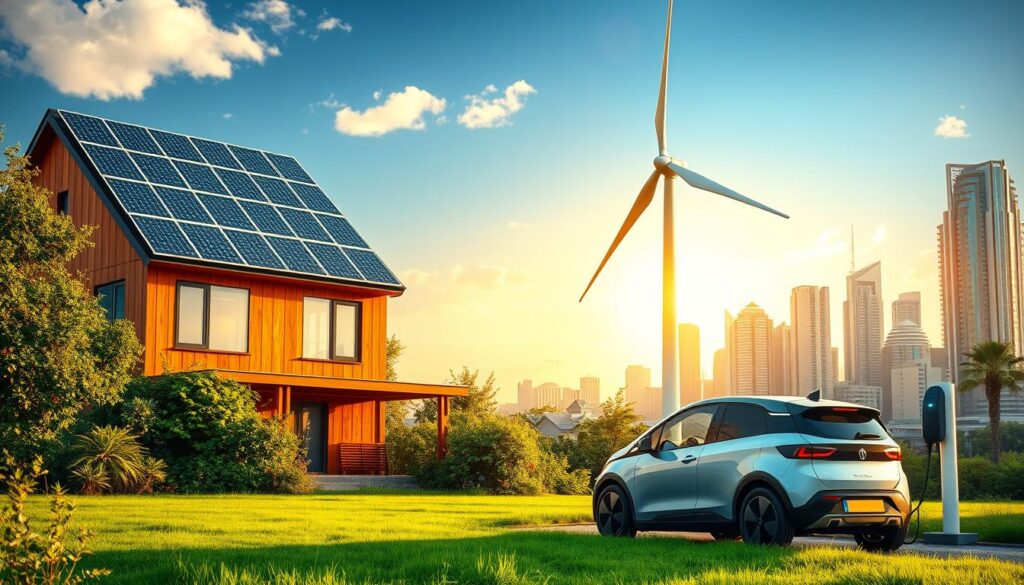
Renewable Energy Options
Renewable energy sources, such as solar and wind power, provide a sustainable alternative to fossil fuels. Solar panels, for instance, can reduce electricity costs by 50-90%, depending on the system size and local energy prices13.
Federal and state tax incentives can cover up to 26% of the installation costs for solar energy systems, making them a financially viable choice for homeowners14. Additionally, energy-efficient HVAC systems can reduce energy consumption by 20-50% compared to traditional systems13.
Here’s a quick overview of renewable energy benefits:
- Solar Panels: Reduce reliance on non-renewable energy and save up to $10,000 over the system’s lifetime14.
- Wind Energy: Ideal for rural areas, offering a clean energy source with minimal carbon emissions.
- Community Solar Projects: Allow homeowners to share solar energy benefits without installing panels on their property.
By investing in renewable energy, you’re not just saving money—you’re contributing to a healthier ecosystem and a more sustainable future. Small changes today can lead to significant long-term benefits for both your home and the planet.
Water Conservation Techniques for a Sustainable Home
Water conservation is a vital practice for sustainable living, offering both environmental and financial benefits. With the average American household using about 300 gallons of water daily, adopting efficient techniques can make a significant difference15.
Simple changes, like installing low-flow fixtures, can reduce indoor water consumption by 20-60%. This not only conserves a precious resource but also lowers utility bills15.
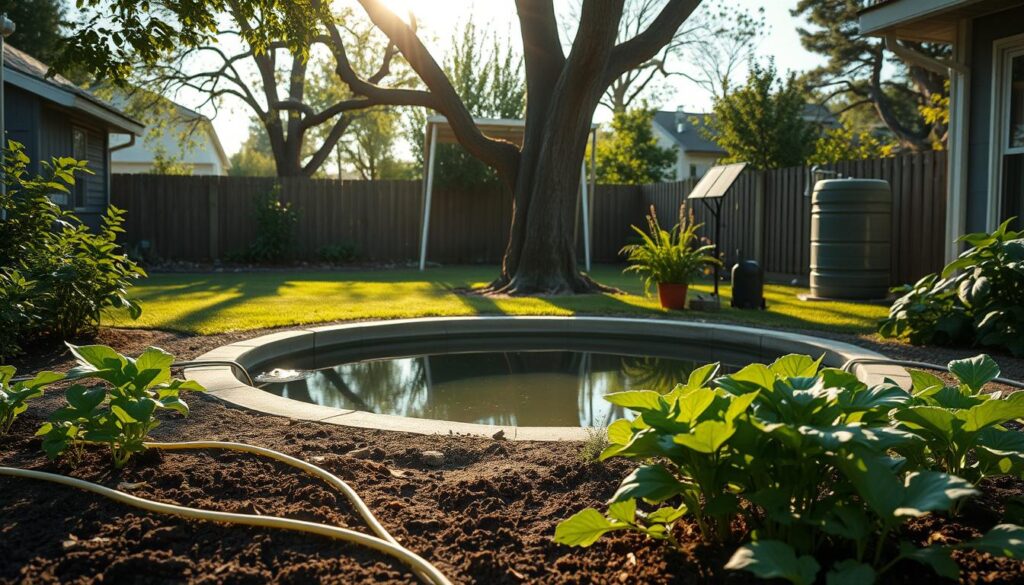
Efficient Fixtures and Rainwater Harvesting
Upgrading to eco-friendly fixtures is a practical way to reduce water waste. Low-flow showerheads and faucets can save hundreds of gallons annually, while low-flow toilets use just 1.28 gallons per flush compared to older models15.
Rainwater harvesting is another effective solution. Systems can provide up to 50% of a household’s water needs for non-potable uses like irrigation and toilet flushing15. This approach reduces reliance on treated water and promotes sustainability.
Here’s a quick guide to water-saving strategies:
| Strategy | Action | Impact |
|---|---|---|
| Low-flow fixtures | Install showerheads and faucets | Reduce water use by 20-60%15 |
| Rainwater harvesting | Set up collection systems | Provide 50% of non-potable water needs15 |
| Drip irrigation | Use for outdoor watering | Save up to 60% compared to sprinklers15 |
| Greywater recycling | Reuse water from sinks and showers | Reduce freshwater use by 50%15 |
Implementing these techniques can lead to a 30-50% reduction in water bills while decreasing your carbon footprint by 15-30%15. These changes not only benefit your household but also contribute to a healthier ecosystem.
By making thoughtful choices, you can conserve water, save money, and protect the environment. Start small, and you’ll see the long-term benefits of sustainable water management.
Selecting Eco-Friendly Products for Daily Living
Choosing eco-friendly products for daily use is a powerful way to reduce your environmental footprint. With 64% of consumers ranking sustainability as a top priority, it’s clear that people are seeking products that align with their values16. But what makes a product truly eco-friendly?
First, look for certifications like Fair Trade, USDA Organic, or Energy Star. These labels verify that a product meets specific environmental standards17. For example, organic cotton uses 91% less water than conventional cotton, making it a better choice for the planet17.

Minimal packaging is another key factor. Products with less plastic or recyclable materials help reduce waste. Brands like Blueland have eliminated over 1 billion single-use plastic bottles, showing how small changes can make a big difference18.
Ethically sourced materials are equally important. Supporting brands that prioritize fair labor practices and sustainable sourcing ensures your purchase has a positive impact. For instance, Manduka’s yoga mats are made from 100% biodegradable natural rubber, offering a sustainable alternative to synthetic options18.
Here are some strategies for identifying eco-friendly products:
- Research the brand’s commitment to sustainability.
- Compare products based on their environmental impact.
- Opt for items with minimal or recyclable packaging.
- Support businesses that prioritize ethical sourcing.
By making thoughtful choices, you can contribute to a healthier ecosystem. Remember, every purchase is an opportunity to support a more sustainable future. Start small, and you’ll see how these changes can transform your daily life and the world around you.
Innovations in Sustainable Home Technology
Innovations in home technology are reshaping how we live sustainably, offering smarter and greener solutions for everyday life. From smart appliances to renewable energy systems, these advancements are transforming households into eco-friendly spaces.
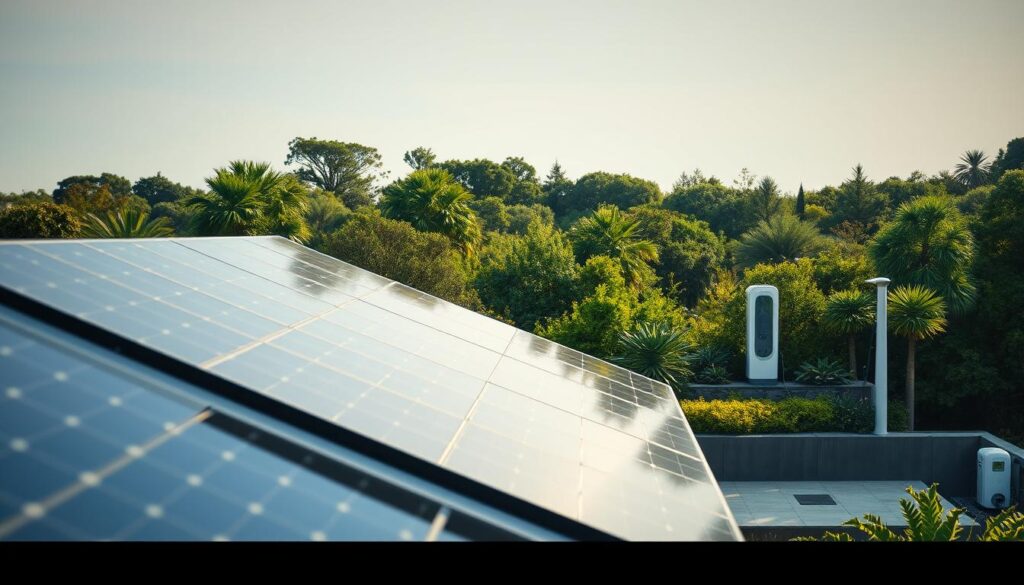
Smart home systems are at the forefront of this transformation. These systems optimize energy consumption by learning user routines and adjusting settings in real-time. For example, smart thermostats can lower energy bills by up to 20% by optimizing heating and cooling based on weather updates19.
Renewable energy technologies are also making a significant impact. Solar panels, paired with smart inverters, can reduce electricity costs by 50-90%19. Additionally, solar-powered devices produce zero greenhouse gas emissions, contributing to a reduction in carbon footprints19.
“The integration of ENERGY STAR®-certified appliances is essential for homes to remain compliant with tightening energy efficiency regulations.”20
Here’s a quick overview of the benefits of sustainable home technologies:
| Technology | Benefit | Impact |
|---|---|---|
| Smart Thermostats | Optimize heating and cooling | Lower energy bills by up to 20%19 |
| Solar Panels | Generate renewable energy | Reduce electricity costs by 50-90%19 |
| LED Lighting | Use less electricity | Substantial energy savings19 |
| Smart Irrigation | Reduce water waste | Save up to 60% of household freshwater19 |
These innovations not only enhance efficiency but also contribute to a healthier ecosystem. By adopting these technologies, homeowners can make a meaningful difference in reducing their environmental impact.
Forward-thinking investments in sustainable home technology combine modern convenience with environmental responsibility. Start small, and you’ll see how these changes can transform your daily life and the world around you.
Greening Your Daily Transportation Choices
Transportation is a major contributor to carbon emissions, but small changes in daily habits can make a big difference. By choosing eco-friendly options, you can reduce your carbon footprint and contribute to a healthier environment.
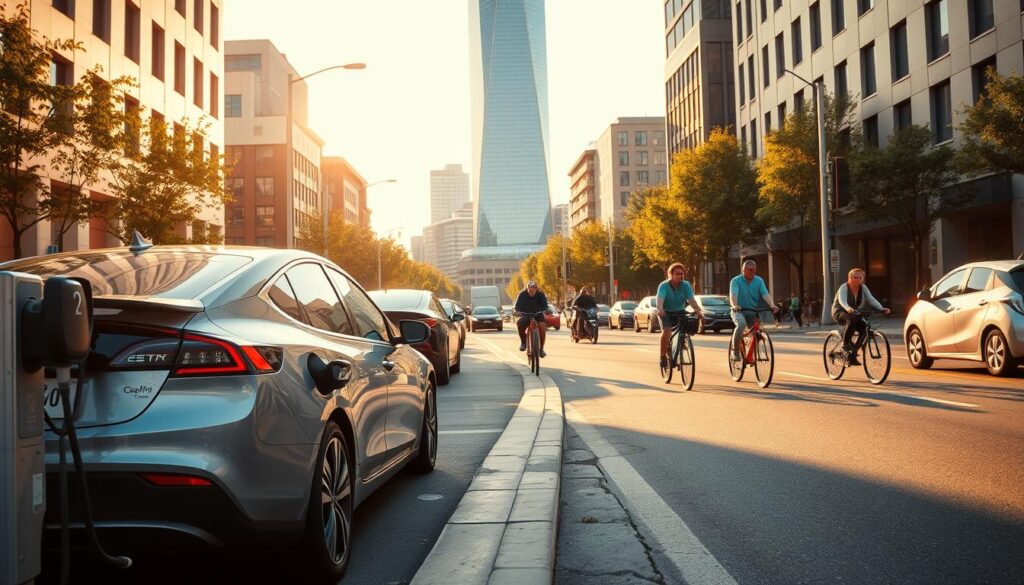
Public transit, cycling, and walking are excellent alternatives to driving. These methods not only lower emissions but also promote physical health. For example, using public transit can reduce individual carbon emissions by up to 37% compared to driving alone21.
Electric and hybrid vehicles are another sustainable choice. These cars produce significantly fewer emissions than traditional gasoline-powered vehicles21. Additionally, federal incentives can make purchasing an electric vehicle more affordable.
Carpooling and ridesharing are effective ways to reduce traffic congestion and emissions. Sharing rides with coworkers or neighbors can cut your carbon footprint by up to 50%21. Many communities also offer programs to encourage carpooling.
Here’s a quick comparison of transportation methods and their environmental impact:
| Method | Emissions Reduction | Additional Benefits |
|---|---|---|
| Public Transit | Up to 37% | Reduces traffic congestion |
| Cycling/Walking | 100% | Improves physical health |
| Electric Vehicles | Up to 50% | Lower fuel costs |
| Carpooling | Up to 50% | Saves money on gas |
Integrating greener transportation into your routine is easier than you think. Start by planning your trips to combine errands or using apps to find carpool partners. Small changes can lead to significant environmental benefits over time.
Community programs also play a vital role in promoting sustainable commuting. Many cities offer incentives for using public transit or carpooling, making it easier to make the switch22.
By adopting these practices, you’re not just reducing your carbon footprint—you’re also contributing to a cleaner, healthier world. Every eco-friendly choice matters.
Shopping Locally and Supporting Your Community
Supporting local businesses isn’t just a trend—it’s a powerful way to reduce your environmental impact while strengthening your community. Over 54% of Americans shop at a local store at least once a month, and 70% do so to improve their local economy23. This simple act has far-reaching benefits for both the planet and your neighborhood.

Local shopping minimizes transportation emissions, a major contributor to greenhouse gases. For example, transporting food via air produces 50 times more emissions than by sea23. By choosing locally sourced products, you’re cutting down on these emissions and supporting a sustainable local economy.
When you purchase from local businesses, more money stays in your community. For every $100 spent at locally owned businesses, $68 remains in the local economy24. This helps small businesses expand, create jobs, and contribute to local non-profits at a rate 250% higher than larger companies23.
Local markets and artisan shops often prioritize eco-friendly practices. Many use minimal packaging, source materials sustainably, and focus on reducing waste. These businesses are also more likely to hire locally, fostering a sense of community and resilience24.
Here are some strategies to support local, sustainable businesses:
- Visit farmers’ markets for fresh, locally grown produce.
- Choose artisan shops for handmade, eco-conscious products.
- Use apps or directories to find locally owned stores in your area.
By making thoughtful purchase decisions, you’re not just buying a product—you’re investing in your community and the planet. Local shopping creates a positive cycle of sustainable consumption and engagement, benefiting everyone involved.
Cultivating an Eco-Conscious Mindset
Cultivating an eco-conscious mindset starts with understanding how daily choices shape the world around us. It’s about seeing the bigger picture and recognizing the impact of every purchase, habit, and decision. This mindset shift is essential for creating a sustainable future25.
Moving from consumerism to sustainable consumption requires a mental shift. Instead of focusing on convenience, consider the long-term effects of your choices. For example, choosing reusable products over single-use items can significantly reduce waste26.

Building awareness is the first step. Start by questioning everyday habits that harm the environment. Simple changes, like reducing energy use or supporting eco-friendly brands, can make a big difference25.
Staying motivated is key. Follow sustainability trends and educate yourself on new practices. Communities that share eco-conscious values can provide support and inspiration26.
Real-life examples show the power of this mindset. For instance, companies like Soda Sense have transformed their business models to prioritize sustainability, offering services that reduce waste and promote renewable resources25.
The long-term benefits are clear. Adopting an eco-centric perspective not only helps the planet but also enhances personal well-being. It’s a journey that requires ongoing effort and commitment.
Encourage education and community engagement to reinforce these values. By working together, we can create a healthier, more sustainable future for everyone26.
Balancing Modern Conveniences with Sustainability
Balancing modern conveniences with sustainability is easier than you think, thanks to innovative solutions that don’t compromise on comfort. Many people believe that being eco-friendly requires sacrificing convenience, but this isn’t the case27. Today’s products and services are designed to meet both needs, offering a seamless blend of functionality and sustainability.

For example, solar panels can reduce electricity costs by 50% or more, while smart thermostats cut heating and cooling expenses by 10-15% annually27. These technologies not only save money but also reduce your carbon footprint. Similarly, LED lighting uses 75% less energy than traditional bulbs, making it a practical choice for eco-conscious consumers28.
When evaluating products, look for certifications like Energy Star or Fair Trade. These labels ensure that the items meet high environmental standards. For instance, eco-friendly appliances can save 20-30% on energy usage, making them a smart purchase for any home27.
“Sustainability doesn’t mean giving up the things you love—it’s about making smarter choices that benefit both your lifestyle and the planet.”
Here’s a quick guide to balancing convenience with sustainability:
| Strategy | Action | Impact |
|---|---|---|
| Energy Efficiency | Install solar panels or LED lighting | Reduce electricity costs by 50%27 |
| Smart Technology | Use smart thermostats or irrigation systems | Save 10-15% on energy bills27 |
| Sustainable Products | Choose certified eco-friendly items | Lower environmental impact28 |
Companies like Soda Sense and Blueland are leading the way by offering products that minimize waste without compromising quality. For example, Blueland has eliminated over 1 billion single-use plastic bottles, proving that sustainability and convenience can go hand in hand29.
By adopting these strategies, you can enjoy modern conveniences while contributing to a healthier planet. Start small, and you’ll see how these changes can transform your daily life and the world around you.
Environmental and Social Values Driving Sustainability
Sustainability is more than just a buzzword—it’s a movement driven by core values that shape both environmental and social progress. These values inspire individuals and businesses to adopt practices that nurture the planet while fostering equality and creativity. By aligning actions with these principles, we can create a more balanced and sustainable future.

Nurturing Nature and Environmental Stewardship
Environmental stewardship is rooted in the belief that we must care for the planet as a shared resource. This means protecting ecosystems, reducing waste, and promoting renewable energy. Companies like Patagonia have led the way by pledging 1% of total sales to environmental preservation, demonstrating how businesses can integrate stewardship into their core mission30.
Consumers are increasingly demanding proof of sustainability values at the point of purchase, pushing brands to adopt transparent practices31. This shift highlights the growing importance of environmental responsibility in both business and daily life.
Embracing Diversity, Tolerance, and Creativity
Social values like diversity and tolerance are equally vital in driving sustainability. These principles encourage inclusive practices and innovative solutions. For example, collaborations like the Adizero x Allbirds shoe, with a carbon footprint of just 2.94 kg CO2e, showcase how creativity can reduce environmental impact30.
Brands that prioritize these values often see increased customer loyalty. Research shows that consumers are willing to pay more for products from companies that align with their ethical beliefs30. This trend underscores the importance of integrating social responsibility into business strategies.
“Sustainability is not just about the environment—it’s about creating a world where everyone thrives.”
True sustainability requires balancing environmental concerns with social responsibility. By nurturing nature and embracing diversity, we can build a future that benefits both people and the planet. Reflect on your own values and consider how they can drive positive change in your daily life.
Overcoming Barriers to Eco-Friendly Purchasing Behavior
Many consumers want to buy eco-friendly products but face challenges in turning their intentions into actions. This gap between intention and behavior is a significant barrier to sustainable consumption32.
One major obstacle is the lack of trust in eco-labels. Studies show that 67% of consumers are more likely to choose products labeled as carbon-neutral or recyclable, but only if they believe the claims are credible33. This highlights the need for transparency in marketing.

Another issue is the ease of purchase. While 90% of consumers claim to prioritize sustainability, only 30% follow through with eco-friendly purchases33. This discrepancy often stems from limited availability or higher costs of sustainable products.
Here are some strategies to bridge the intention-action gap:
- Improve product information to build consumer trust.
- Increase the availability of eco-friendly options in mainstream stores.
- Use simple nudges, like green leaf symbols, to guide purchase decisions34.
Companies like Blueland have successfully addressed these challenges by offering reusable packaging and clear labeling. Their approach has eliminated over 1 billion single-use plastic bottles, proving that transparency and accessibility can drive consumer behavior33.
“Sustainability isn’t just about the product—it’s about making it easy for customers to make the right choice.”
By focusing on these strategies, businesses and consumers can work together to close the intention-action gap. Small changes in how products are marketed and sold can lead to significant environmental benefits.
Ultimately, overcoming these barriers requires a collaborative effort. Businesses must prioritize transparency, while consumers need to demand and support sustainable options. Together, we can create a more eco-friendly future.
Conclusion
Small, intentional changes in daily habits can lead to a significant positive impact on the planet. From reducing waste to choosing eco-friendly products, every action contributes to a healthier future. This article has explored practical strategies to make your home more sustainable, from energy efficiency to water conservation.
By adopting these practices, you not only reduce your carbon footprint but also save money and improve your quality of life. For example, using a programmable thermostat can cut energy bills by 10-15%35, while low-flow fixtures reduce water usage by 30%35. These small steps add up to a larger, global difference.
Supporting sustainable brands and making mindful purchases also play a crucial role. Research shows that eco-friendly products often last longer and perform better, offering long-term savings36. Together, these choices create a ripple effect, encouraging more businesses to adopt sustainable practices.
Start today by integrating one or two of these strategies into your routine. Every choice matters, and your efforts contribute to a healthier planet for future generations. Thank you for taking this journey toward sustainability—let’s continue making a difference, one step at a time.
FAQ
What does it mean to live an eco-conscious lifestyle?
How can I make my home more energy-efficient?
What are some simple ways to reduce waste at home?
How can I conserve water in my household?
What should I look for when buying eco-friendly products?
How does shopping locally benefit the environment?
What are the benefits of renewable energy for my home?
How can I adopt a more eco-friendly mindset?
What role does transportation play in eco-conscious living?
How can I balance modern conveniences with sustainability?
Source Links
- The Ultimate 20 step Guide to Eco-friendly Living | Good Energy – https://www.goodenergy.co.uk/blog/the-ultimate-20-step-guide-to-eco-friendly-living/
- How to achieve environmental sustainability – https://greenly.earth/en-us/blog/company-guide/how-to-achieve-environmental-sustainability
- The Values That Drive Eco-Conscious Consumers: Nature, Equality, Tolerance and Creativity | Media Culture – https://www.mediaculture.com/insights/the-values-that-drive-eco-conscious-consumers-nature-equality-tolerance-and-creativity
- How Sustainability and Eco-Consciousness Are Shaping Modern Consumer Behavior – https://www.linkedin.com/pulse/how-sustainability-eco-consciousness-shaping-modern-consumer-hl8nc
- Understanding Eco-Consciousness: How Our Earth-Friendly Poo Bags Make – https://petwipes.co.uk/blogs/news/understanding-eco-consciousness-how-our-earth-friendly-poo-bags-make-a-difference?srsltid=AfmBOooQkQNjVNMQvUQSKoZDLWIUtdYeRyBh1IhgQ-ya_7ck7t7sVutI
- Eco-Friendly Parenting: Teaching Kids Sustainable Choices for a Greener Future – https://americanspcc.org/eco-friendly-parenting-teaching-kids-sustainable-choices-for-a-greener-future/
- Sustainable Living : key points that differentiate homes as leaders – https://oreereality.com/sustainable-living-for-families-features-that-make-your-home-healthy-and-eco-friendly/
- Sustainable Living – Eco-friendly Home Choices – https://www.hammockuniverse.com/blogs/hammock-blog/sustainable-living-eco-friendly-home-choices?srsltid=AfmBOorpFASY-JLiibH-dYUCS8toqYFJnAy4Tn_2rRavlZkrCUURSV6z
- The Essential Guide to Sustainable Living: Embracing an Eco-Friendly Future – https://www.hulkapps.com/blogs/ecommerce-hub/the-essential-guide-to-sustainable-living-embracing-an-eco-friendly-future
- Here’s Why Embracing Green Living Is Crucial for Our Future — Green and Prosperous – https://www.greenandprosperous.com/blog/heres-why-embracing-green-living-is-crucial-for-our-future
- Eight Ways to Reduce Waste – https://www.nature.org/en-us/about-us/where-we-work/united-states/delaware/stories-in-delaware/delaware-eight-ways-to-reduce-waste/
- A Guide to Sustainable Waste Management at Home | Green Living Blog – https://www.greenlivingblog.org.uk/sustainable-home-waste-management-guide/
- The Environmental Impact of Energy-Efficient Homes – https://www.atlashomeenergy.com/blog/posts/view/the-environmental-impact-of-energy-efficient-homes
- Eco-Friendly Living: Enhancing Energy Efficiency at Home – https://kingsriverlife.com/07/02/eco-friendly-living-enhancing-energy-efficiency-at-home/
- Warhome | Water Conservation Techniques in Eco-Friendly Home Design – https://www.warehome.co.uk/articles/water-conservation-techniques-in-eco-friendly-home-design
- 34 Eco-Friendly Products To Sell in 2025 for Sustainability – Shopify – https://www.shopify.com/blog/eco-friendly-products
- 50 Ethical and Eco-Friendly Replacements to Everyday Products – https://www.causeartist.com/eco-friendly-ethical-alternatives-everyday-products/
- 36 Eco-Friendly Products to Help You Live Sustainably Every Day – https://www.oprahdaily.com/life/g39730306/best-sustainable-products/
- Future-Proof Your Home: Top Eco-Smart Innovations for a Sustainable 2025 – https://biofriendlyplanet.com/future-proof-your-home-top-eco-smart-innovations-for-a-sustainable-2025/
- Building the Future: Sustainable Home Design – https://www.nahb.org/blog/2025/02/lg-sponsored
- How to Stay Green in Your Daily Life: Smart Facts for Eco-Conscious Living – https://www.intertraffic.com/news/how-to-stay-green-in-your-daily-life
- Traveling Eco-Consciously: Your Essential Guide – https://pure-suds.com/blogs/healthy-home-healthy-life/traveling-eco-consciously-guide?srsltid=AfmBOorvcDpgsXWqnUbJyRSwKpvSMCJwLswjx9SG97yrxKP1JY04bOlD
- How does supporting local businesses help the environment and economy? Here are 9 ways – Kiwi Energy – https://kiwienergy.us/blog/how-does-supporting-local-businesses-help-the-environment/
- The Power Of Shopping Small: Supporting Your Local Community – https://www.admoyer.com/blog/the-power-of-shopping-small-supporting-your-local-community-bpid_58.aspx
- 10 Ways to Be More Eco-Conscious – https://sodasense.com/blogs/bubbly-blog/eco-conscious-living-tips?srsltid=AfmBOoqzKf_wYIoFA1ljhQ3nX1JeSwQkpgQ_CWVHPvc26Z4EW8_pkoX_
- 30 Ways to Make Your Workplace Culture More Eco-Friendly | Cooleaf – https://www.cooleaf.com/blog/green-workplace
- Sustainability vs. Convenience: The Myth of Sacrificing Comfort for Eco-Friendly Living – ecoShuttle Charter & Tours – https://ecoshuttle.com/sustainability-vs-convenience-the-myth-of-sacrificing-comfort-for-eco-friendly-living/
- A Guide to Creating an Eco-Friendly Smart Home – https://power.solar/go-green-at-home-a-guide-to-creating-an-eco-friendly-smart-home/
- Balancing sustainability and effectiveness. – https://manufacturing-today.com/news/balancing-sustainability-and-effectiveness/
- 3 Ways To Align Your Marketing With Eco-Conscious Consumers – Marketing Insider Group – https://marketinginsidergroup.com/best-practices/3-ways-to-align-your-marketing-with-eco-conscious-consumers/
- Why The Rise Of Sustainability Is A Shift In Consumer Conciousness – https://www.forbes.com/sites/sap/2024/05/14/why-the-rise-of-sustainability-is-a-shift-in-consumer-conciousness/
- A multidimensional lens of environmental consciousness: towards an environmentally conscious theory of planned behavior – https://www.emerald.com/insight/content/doi/10.1108/jcm-03-2023-5875/full/html
- Sustainability in Market Research: Eco-Friendly Consumer Trends – https://ttconsultants.com/sustainability-in-market-research-measuring-consumer-preferences-for-eco-friendly-products/
- Nudge, Nudge, Green Boost: How To Encourage Sustainable Buying Behavior Among Online Shoppers – https://www.newneuromarketing.com/nudge-nudge-green-boost-how-to-encourage-sustainable-buying-behavior-among-online-shoppers
- Eco-Conscious Living: Small Changes, Big Impact! – https://www.swastiyogacenter.com/eco-conscious-living-small-changes-big-impact/
- Top 5 Benefits of Using Eco-Friendly Products Year-Round – https://www.earth-smart-solutions.com/blogs/blog/top-5-benefits-of-using-eco-friendly-products-year-round
